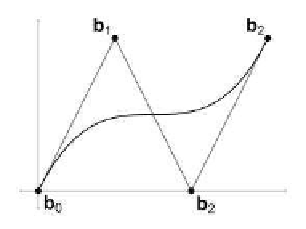Game Development Reference
In-Depth Information
control points are farther away from their neighboring endpoint than one-third of the total
interval; the distance is equal to the total interval length. So the starting and ending
velocities are three times as fast. This means we are starting off “too fast” and will have
to slow down in the middle somewhere, and then accelerate back up to the high velocity
at the end. How slow do we have to go? Let's plot the curve to see.
Here the control points are spaced evenly on the x-axis, and so it moves at constant
horizontal velocity. The y-coordinates are distributed according to the description for this
exercise, and as you can see, the initial vertical velocity is large, it slows down to a minimum
at t = 1/2, and then accelerates to a high final velocity. Judging from the diagram, the
slope is horizontal at the midpoint t = 1/2, which means that the vertical velocity is zero.
9. We can solve this algebraically. First, we need to convert our answer from Exercise 2 into a
curve in monomial form with a normalized parameter. Remember that the curve is traced
out as t varies from 0 to 2, but all of our curves have been using an argument that varies
from 0 to 1. So we'll set s = t/2 and come up with a new curve in terms of s:
t
2
+
−h
d/2
2h
p(t) =
t,
(2s)
2
+
−h
d/2
2h
p(s) =
(2s),
s.
−4h
d
4h
s
2
+
=
Writing out the monomial coe
cients, we get
d
4h
−4h
c
0
= 0,
c
1
=
,
c
2
=
,
c
3
= 0.
Now we can convert to Bezier form by using Equations (13.20)-(13.23):
b
0
= c
0
= 0,
d
4h
d/3
4h/3
b
1
= c
0
+ (1/3)c
1
= (1/3)
=
,
b
2
= c
0
+ (2/3)c
1
+ (1/3)c
2
−4h
d
4h
2d/3
8h/3
0
−4h/3
2d/3
4h/3
= (2/3)
+ (1/3)
=
+
=
,
d
4h
−4h
d
0
b
3
= c
0
+ c
1
+ c
2
+ c
3
=
+
=
.









Search WWH ::

Custom Search